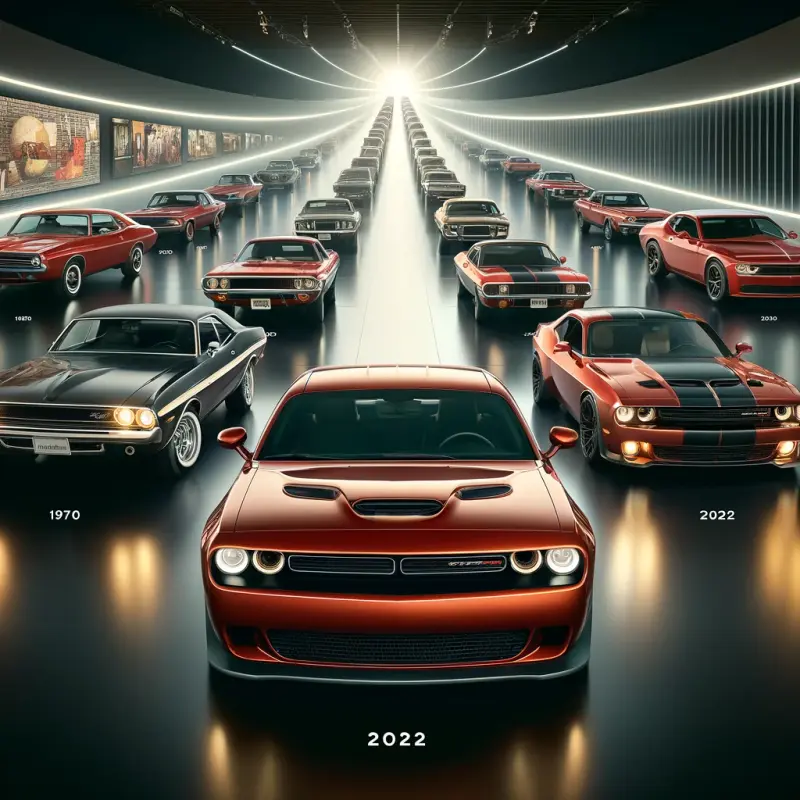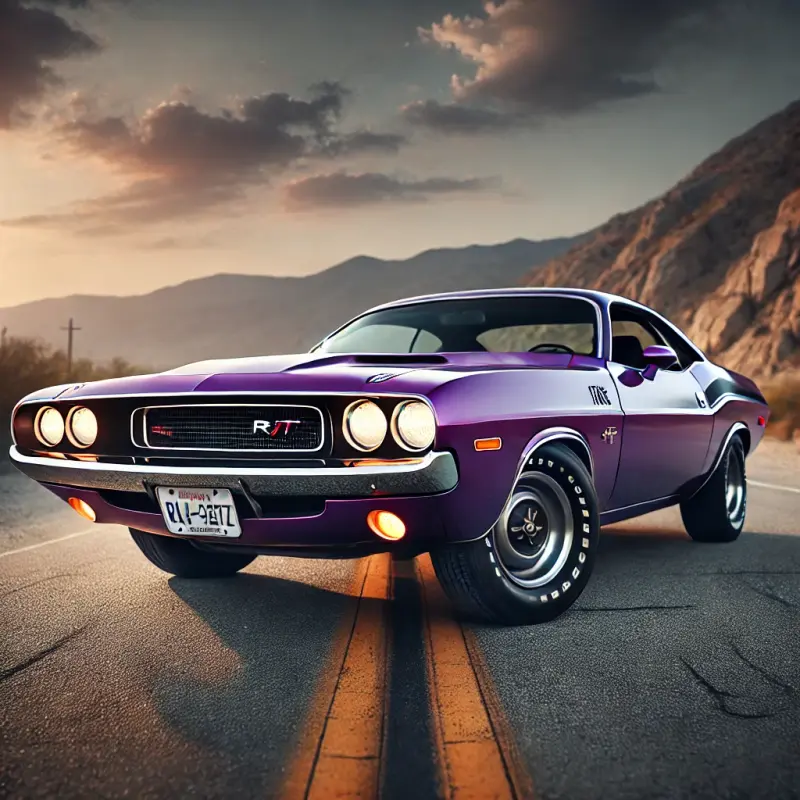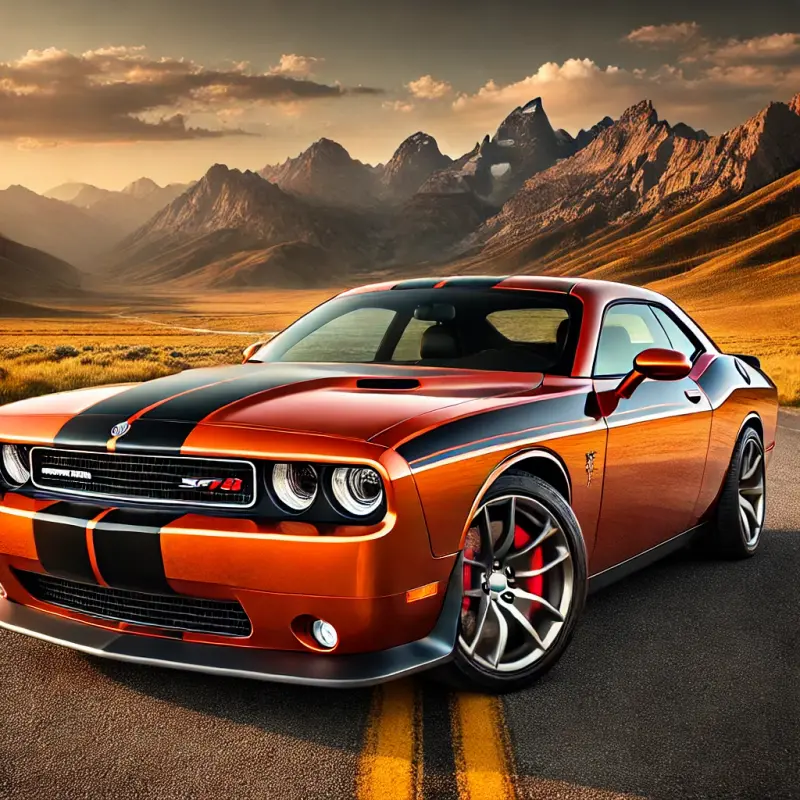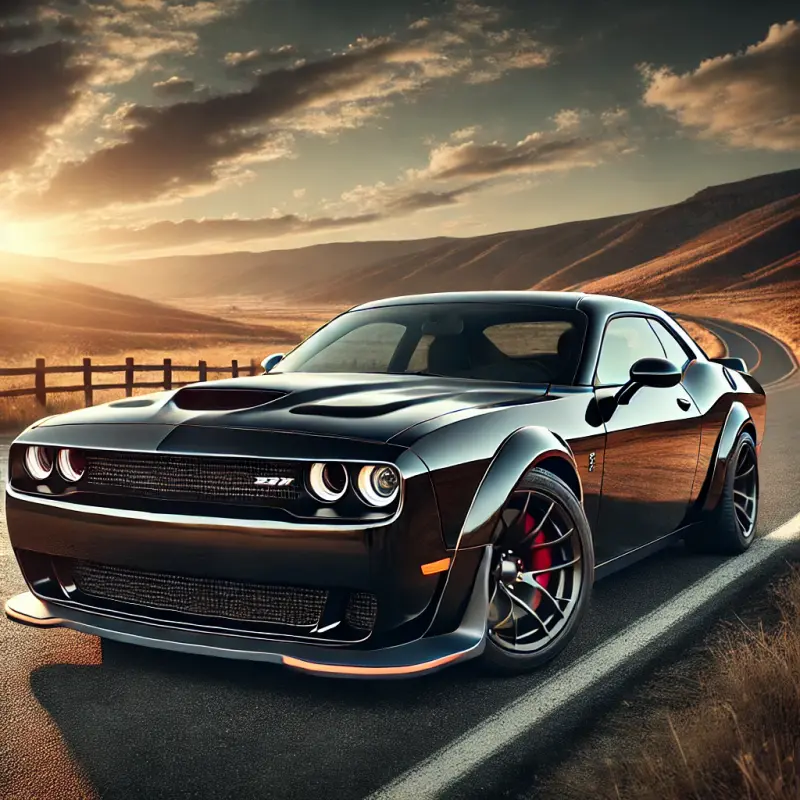The History of the Dodge Challenger: A Muscle Car Legacy

The Dodge Challenger is one of the most iconic muscle cars in automotive history. Known for its powerful engines, aggressive design, and deep-rooted ties to American automotive culture, the Challenger has carved out a significant place in car enthusiasts' hearts over the decades. Whether you’re a fan of classic muscle cars or modern performance vehicles, the Challenger has played an integral role in shaping the legacy of muscle cars in America.
In this blog, we will take an in-depth look at the history of the Dodge Challenger, tracing its roots from its debut in the 1970s to its revival in the 21st century. Let’s explore how the Challenger has evolved over time, overcoming challenges and solidifying its place as a symbol of American performance.
Table of Contents
Introduction to the Dodge Challenger
The Muscle Car Era and the Challenger’s Birth (1960s-1970)
The Rise of the Muscle Car
Dodge’s Entry into the Muscle Car Market
The Birth of the Challenger: Design and Engineering
The Challenger’s Success in the 1970s
The Challenger’s Initial Popularity
The Performance Models: R/T and HEMI V8
Challenger’s Competitors: Mustang and Camaro
The Muscle Car Crisis and Challenger’s Decline (1974-1980s)
The Return of the Dodge Challenger: 2000s Revival
Early 2000s Muscle Car Renaissance
The Concept Car and Public Reception
Production Begins: 2008 Challenger
The Challenger Today: Modern Muscle (2010s-Present)
Evolution of Engine Options
Technological Updates and Interior Features
The SRT Demon and Hellcat Models
Challenger vs. Competitors: Mustang and Camaro Rivalry
Comparing Design, Performance, and Pricing
Challenger’s Unique Position in the Muscle Car Market
Pop Culture and the Challenger’s Influence
The Challenger in Film, Music, and Media
The Challenger’s Role as an Automotive Icon
Challenges and Future of the Dodge Challenger
Conclusion: The Enduring Legacy of the Dodge Challenger
1. Introduction to the Dodge Challenger
The Dodge Challenger is an unmistakable symbol of American automotive power, representing the heart of the muscle car era. With its wide stance, powerful engines, and aggressive styling, the Challenger has become synonymous with high-performance driving and a defiant attitude towards convention. Whether you’re talking about the first-generation Challenger from the 1970s or the modern iterations that carry the name today, the Challenger remains a car built for enthusiasts who appreciate raw performance and bold design.
Introduced as a competitor to the likes of the Ford Mustang and Chevrolet Camaro, the Challenger didn’t just aim to meet the demand for fast cars—it set the standard. But its history has been far from simple. The Challenger’s journey has been marked by periods of both incredible success and decline, and its revival in the 21st century has cemented its status as a modern classic.
2. The Muscle Car Era and the Challenger’s Birth (1960s-1970)
The Rise of the Muscle Car
The 1960s marked the peak of the muscle car era in America. The post-World War II boom created a culture of youth rebellion and freedom, and what better way to embody that spirit than with powerful, affordable performance cars. Automakers responded with an explosion of models that emphasized speed, power, and style. Cars like the Chevrolet Corvette, Ford Mustang, and Plymouth Barracuda defined this golden age of American muscle.
The rise of the muscle car coincided with a time when Americans were more interested in horsepower than ever before. Chrysler, Dodge’s parent company, understood this demand and sought to carve out its own niche in the market. Dodge had previously been known for its trucks and family vehicles, but it recognized the opportunity to develop a performance car that would rival Ford and Chevrolet’s offerings.
Dodge’s Entry into the Muscle Car Market
In 1966, Chrysler launched its Plymouth Barracuda, which had a significant impact on the performance car market. Although the Barracuda was successful, Chrysler’s attention quickly turned to its next big project: a car that could compete directly with the growing muscle car market. Dodge was tasked with creating a car that could rival Ford’s Mustang and the Chevrolet Camaro—two highly popular muscle cars of the time.
Dodge had already released the Dodge Coronet and Dodge Charger, but these were larger and more luxury-oriented. A smaller, performance-oriented vehicle was needed to grab the attention of younger, performance-hungry buyers. Thus, the decision was made to develop the Challenger.
The Birth of the Challenger: Design and Engineering
Dodge’s design team, led by Carl Cameron, set about developing the Challenger. They turned to Chrysler’s E-body platform, which was designed to be a versatile and adaptable platform that could accommodate various engine options and body styles. The E-body platform would be shared with the Plymouth Barracuda, but Dodge aimed to create a distinct car with unique features.
The Challenger was launched in 1970, and it featured bold, aggressive styling that set it apart from the competition. The front end was long and muscular, with a wide stance and a powerful grille. The car’s design was unmistakably aggressive, with high-performance options that would give it the muscle car identity it needed to compete.
Dodge offered a variety of engine options, including a 225-cubic inch Slant-6 engine, 318 V8, and the formidable 426 HEMI V8, which was capable of producing 425 horsepower. The HEMI engine was a game-changer, elevating the Challenger to a level of performance that was unmatched by most competitors.

3. The Challenger’s Success in the 1970s
The Challenger’s Initial Popularity
The Dodge Challenger quickly became popular after its release, thanks to its stunning looks and powerful performance options. The car was available in a variety of trims and configurations, allowing buyers to choose from a base model with a Slant-6 engine, or step up to a more powerful R/T model equipped with the HEMI V8.
The Challenger was seen as the quintessential muscle car, combining bold styling with powerful engines. The success of the Challenger helped Dodge secure a foothold in the highly competitive muscle car market, and it began to attract attention from car enthusiasts and performance car buyers across the nation.
The Performance Models: R/T and HEMI V8
The Challenger’s R/T trim level was the model that truly made a statement. R/T, which stood for “Road and Track,” was the performance version of the Challenger, and it was equipped with an array of performance enhancements. The R/T package featured a sportier suspension, wider tires, and, most notably, the high-performance 426 HEMI V8 engine.
The HEMI V8 was one of the most legendary engines ever created by Chrysler. It was known for its high output and impressive track performance, and it made the Challenger one of the most powerful cars on the road. This engine allowed the Challenger to compete against the fastest muscle cars of the time, including the Ford Mustang Boss 429 and the Chevrolet Camaro SS.
Challenger’s Competitors: Mustang and Camaro
Despite its success, the Challenger was up against fierce competition from the Ford Mustang and Chevrolet Camaro, which were both established muscle cars with strong followings. The Mustang, in particular, had been around since 1964 and had already captured the attention of the American public with its combination of style and performance.
However, the Challenger held its own against these rivals, thanks to its aggressive design, powerful engine options, and the HEMI V8’s incredible performance. While Ford and Chevrolet were releasing new performance variants of their own, the Challenger continued to stand out as a bold, unapologetic muscle car.
4. The Muscle Car Crisis and Challenger’s Decline (1974-1980s)
The Energy Crisis and Regulatory Pressure
The early 1970s brought challenges that no one could have predicted. The 1973 oil crisis caused a dramatic spike in fuel prices, and Americans’ interest in fuel-hungry performance cars began to wane. At the same time, increasing government regulations on emissions and safety forced automakers to rethink their approach to performance cars. These factors led to the muscle car crisis, during which sales of high-performance vehicles like the Challenger dropped significantly.
Automakers, including Dodge, found it increasingly difficult to produce high-powered vehicles that met new environmental and safety standards. This contributed to a decline in the muscle car market and caused many iconic models to be discontinued.
Discontinuation of the Challenger
By 1974, the Challenger’s sales had dwindled, and Dodge made the difficult decision to discontinue the model. The Challenger was effectively retired after just five years of production. Despite its relatively short production run, the Challenger had left a lasting legacy in the muscle car world. But for the time being, it seemed that the era of high-performance, big-block V8 cars had come to an end.
Dodge’s Shift in Focus
In the years following the Challenger’s discontinuation, Dodge shifted its focus toward more economical and practical vehicles, such as the Dodge Aspen and Dodge Omni. The muscle car era had officially come to an end, but the Challenger’s legacy was far from over.

5. The Return of the Dodge Challenger: 2000s Revival
Early 2000s Muscle Car Renaissance
By the early 2000s, the muscle car market began to show signs of life again. American automakers, especially Ford, Chevrolet, and Chrysler, recognized that there was a growing demand for high-performance cars. The Ford Mustang was revived in 2005, and the Chevrolet Camaro followed suit in 2009. It was clear that the time was right for a muscle car revival.
Chrysler, not to be left behind, began work on resurrecting the Dodge Challenger.
The Concept Car and Public Reception
In 2006, Chrysler unveiled the Dodge Challenger Concept at the North American International Auto Show in Detroit. The concept car was a retro-inspired design that paid homage to the original 1970 Challenger, while incorporating modern touches and technology. The response to the concept car was overwhelmingly positive, with many car enthusiasts clamoring for its production.
Chrysler listened to the demand, and by 2008, the Challenger was back in production, much to the delight of muscle car fans.
Production Begins: 2008 Challenger
The 2008 Dodge Challenger was a direct successor to the classic muscle car, but it was equipped with modern features that appealed to a new generation of performance enthusiasts. The car retained its iconic styling, including the long hood, wide body, and aggressive front end, while adding new technology and luxury features to enhance the driving experience.
The 2008 Challenger was available with several engine options, including the 3.5-liter V6, 5.7-liter HEMI V8, and 6.1-liter HEMI V8. The car’s updated performance capabilities allowed it to compete with the Ford Mustang GT and Chevrolet Camaro SS in the modern muscle car market.
6. The Challenger Today: Modern Muscle (2010s-Present)
Evolution of Engine Options
The Dodge Challenger has continued to evolve in the 2010s, with Chrysler adding more powerful engine options, including the 707-horsepower Hellcat V8 and the 797-horsepower Redeye engine. The Hellcat and Redeye variants of the Challenger have become incredibly popular among enthusiasts due to their immense power and jaw-dropping performance. These cars are capable of reaching 0-60 mph in under 4 seconds, making them among the fastest muscle cars ever built.
Technological Updates and Interior Features
Modern Challengers come equipped with the latest technology and interior features, making them more comfortable and practical for everyday use. From the Uconnect infotainment system to advanced driver assistance features, the Challenger blends high-performance with modern convenience.
The SRT Demon and Hellcat Models
The Dodge Challenger SRT Demon, released in 2018, was one of the most powerful muscle cars ever made. With a 840-horsepower engine and incredible acceleration, the Demon was designed for track enthusiasts and those looking for raw, unbridled power. The SRT Hellcat continues to be a standout performance model, with multiple variations and plenty of power under the hood.

7. Challenger vs. Competitors: Mustang and Camaro Rivalry
The modern Dodge Challenger competes directly with the Ford Mustang and Chevrolet Camaro—two of its oldest rivals in the muscle car world. Each car brings something unique to the table, but the Challenger stands out with its larger size, more aggressive styling, and massive engine options.
Comparing Design, Performance, and Pricing
While the Ford Mustang offers agile handling and a range of engine options, the Chevrolet Camaro has focused more on high-performance variants. The Challenger, however, brings a balance of raw power, comfort, and style, which gives it a unique position in the market.
8. Pop Culture and the Challenger’s Influence
The Challenger’s role in pop culture cannot be overstated. From its appearances in films like The Fast and the Furious to its place in music videos, the Challenger has earned a place in the public’s consciousness as the quintessential muscle car. It represents freedom, rebellion, and the thrill of the open road—values that have come to define its place in history.
9. Challenges and Future of the Dodge Challenger
As we enter an era of electric vehicles and evolving environmental regulations, the future of muscle cars like the Dodge Challenger remains uncertain. However, Dodge has hinted at introducing hybrid and electric muscle cars in the coming years, ensuring the legacy of performance and power continues.
10. Conclusion: The Enduring Legacy of the Dodge Challenger
From its inception in the 1970s to its modern iterations, the Dodge Challenger has proven itself to be much more than just a car—it is a symbol of American muscle, engineering excellence, and the thrill of the open road. Despite facing setbacks and challenges over the years, the Challenger’s legacy endures, cementing its place in automotive history as a true icon. Whether you’re behind the wheel of a classic model or the latest Hellcat, the Dodge Challenger continues to inspire and excite automotive enthusiasts around the world.